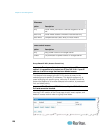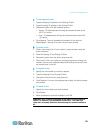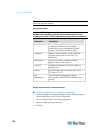
Chapter 4: Virtual Media
115
c. Click Connect.
3. For ISO images:
a. Choose the ISO Image option. Use this option when you want to
access a disk image of a CD, DVD, or hard drive. ISO format is
the only format supported.
b. Click the Browse button.
c. Navigate to the path containing the disk image you want to use
and click Open. The path is populated in the Image Path field.
d. Click Connect.
4. For remote ISO images on a file server:
a. Choose the Remote Server ISO Image option.
b. Choose Hostname and Image from the drop-down lists. The file
servers and image paths available are those that you configured
using the File Server Setup page. Only items you configured
using the KX II-101 File Server Setup page will be in the drop-
down list. See File Server Setup (File Server ISO Images
Only) (on page 111) for more information.
c.
File Server
Username - User name required for access to the file
server.
d. File Server Password - Password required for access to the file
server (field is masked as you type).
e. Click Connect.
The media will be mounted on the target server virtually. You can
access the media just like any other drive.
Note: If you are working with files on a Linux target, use the Linux Sync
command after the files are copied using virtual media in order to view
the copied files. Files may not appear until a sync is performed.
Disconnecting Virtual Media
To disconnect the virtual media drives:
• For local drives, choose Virtual Media > Disconnect Drive.
• For CD-ROM, DVD-ROM, and ISO images, choose Virtual Media >
Disconnect CD-ROM/ISO Image.
Note: In addition to disconnecting the virtual media using the Disconnect
command, simply closing the KVM connection closes the virtual media
as well.


















